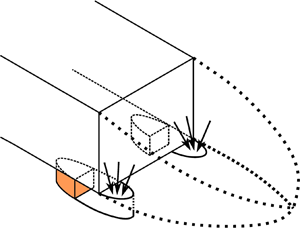Graphical abstract from Zolfaghari, H., Kerswell, R., Obrist, D. & Schmid, P. 2022 Sensitivity and downstream influence of the impinging leading-edge vortex instability in a bileaflet mechanical heart valve. J. Fluid Mech. 936, A41. doi:10.1017/jfm.2022.49.
JFM Rapids
A spectral method for axisymmetric Stokes flow past a particle
-
- Published online by Cambridge University Press:
- 11 February 2022, R1
-
- Article
-
- You have access
- Open access
- HTML
- Export citation
A new scaling for the flow instability past symmetric bluff bodies
-
- Published online by Cambridge University Press:
- 15 February 2022, R2
-
- Article
- Export citation
A solution for the quasi-one-dimensional linearised Euler equations with heat transfer
-
- Published online by Cambridge University Press:
- 17 February 2022, R3
-
- Article
-
- You have access
- Open access
- HTML
- Export citation
Focus on Fluids
Causality between fluid motions and bathymetric features
-
- Published online by Cambridge University Press:
- 07 February 2022, F1
-
- Article
-
- You have access
- HTML
- Export citation
JFM Papers
Vortex breakdown in variable-density gaseous swirling jets
-
- Published online by Cambridge University Press:
- 07 February 2022, A1
-
- Article
- Export citation
Near wake interactions and drag increase regimes for a square-back bluff body
-
- Published online by Cambridge University Press:
- 08 February 2022, A2
-
- Article
-
- You have access
- Open access
- HTML
- Export citation
The unsteady aerodynamics of insect wings with rotational stroke accelerations, a systematic numerical study
-
- Published online by Cambridge University Press:
- 07 February 2022, A3
-
- Article
-
- You have access
- Open access
- HTML
- Export citation
Wake behind a discontinuous cylinder: unveiling the role of the large scales in wake growth and entrainment
-
- Published online by Cambridge University Press:
- 07 February 2022, A4
-
- Article
- Export citation
On the polydisperse particle migration and formation of chains in a square channel flow of non-Newtonian fluids
-
- Published online by Cambridge University Press:
- 08 February 2022, A5
-
- Article
- Export citation
Linear instability analysis of a viscoelastic jet in a co-flowing gas stream
-
- Published online by Cambridge University Press:
- 07 February 2022, A6
-
- Article
- Export citation
Global modes of viscous heated jets with real gas effects
-
- Published online by Cambridge University Press:
- 07 February 2022, A7
-
- Article
- Export citation
Accelerated decay of a Lamb–Oseen vortex tube laden with inertial particles in Eulerian–Lagrangian simulations
-
- Published online by Cambridge University Press:
- 07 February 2022, A8
-
- Article
-
- You have access
- Open access
- HTML
- Export citation
Scaling the self-propulsive performance of pitching and heaving flexible plates
-
- Published online by Cambridge University Press:
- 07 February 2022, A9
-
- Article
- Export citation
Closure mechanism of the A1 and A2 modes in jet screech
-
- Published online by Cambridge University Press:
- 07 February 2022, A10
-
- Article
-
- You have access
- Open access
- HTML
- Export citation
A numerical investigation of granular shock waves over a circular cylinder using the discrete element method
-
- Published online by Cambridge University Press:
- 07 February 2022, A11
-
- Article
- Export citation
Computational modelling of Leidenfrost drops
-
- Published online by Cambridge University Press:
- 07 February 2022, A12
-
- Article
-
- You have access
- Open access
- HTML
- Export citation
Multipolar spherical and cylindrical vortices
-
- Published online by Cambridge University Press:
- 07 February 2022, A13
-
- Article
-
- You have access
- Open access
- HTML
- Export citation
A hybrid pseudo-incompressible–hydrostatic model
-
- Published online by Cambridge University Press:
- 11 February 2022, A14
-
- Article
-
- You have access
- Open access
- HTML
- Export citation
Optimal growth over a time-evolving variable-density jet at Atwood number $\vert \textit {At} \vert = 0.25$
-
- Published online by Cambridge University Press:
- 11 February 2022, A15
-
- Article
- Export citation
Generation of acoustic tones in round jets at a Mach number of 0.9 impinging on a plate with and without a hole
-
- Published online by Cambridge University Press:
- 11 February 2022, A16
-
- Article
- Export citation
























































































